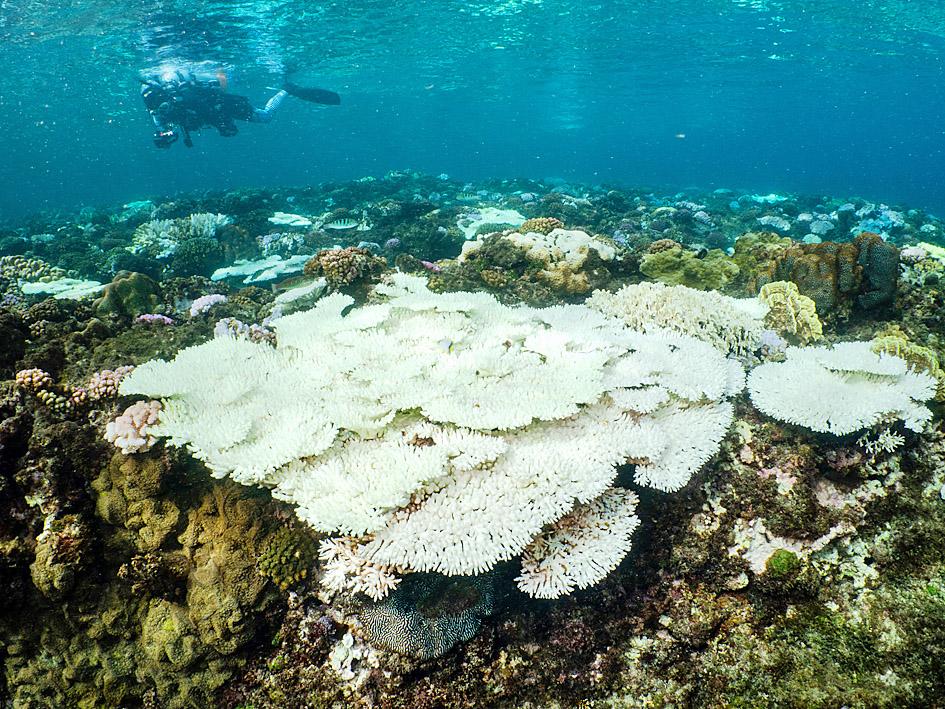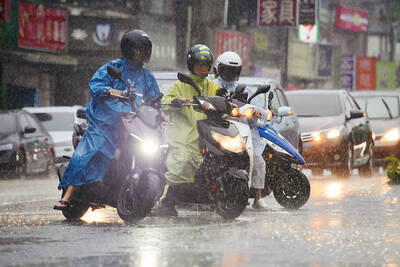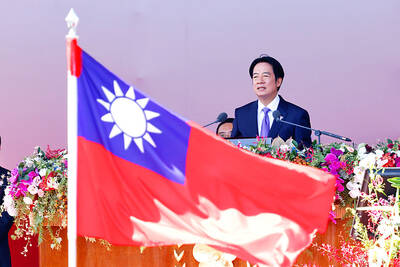At least 31 percent of the coral reefs in waters around Taiwan are dying as a result of bleaching, which is now the worst in its recorded history, researchers from Academia Sinica and the Taiwan Coral Bleaching Observation Network (TCBON) said yesterday, echoing warnings first delivered in September.
The network said that 52 percent of the coral in the nation’s waters is under different levels of heat stress, while 31 percent is in an irreversible process of dying due to high water temperatures.
The coral reefs would not recover, even if the water temperatures fall, said Kuo Chao-yang (郭兆揚), a postdoctoral research associate at Academia Sinica’s Biodiversity Research Center and a TCBON member.

Photo: CNA
The coral bleaching, the worst since the government began keeping such records in the 1980s, was a result of global warming and a low incidence of typhoons in the country last summer, he said.
Average sea temperatures around the nation last year rose to the highest in two decades, Kuo said, citing an average 30.5°C in waters off the north coast last summer, about 1°C above normal.
The optimal water temperature for coral growth is 18°C to 29°C, and in unfavorable conditions, most corals expel their symbiotic algae, causing bleaching or even death, Kuo said.
The areas around Taiwan where the worst bleaching occurred last year were Liouciou Island (琉球), Kenting, the northeast coast, Penghu and Green Island (綠島), he said.
Mingo Lee (李世明), a diver who helps document the condition of Taiwan’s coral, said the underwater temperature near uninhabited Siji Island (西吉) in Penghu County was about 34°C when he dove there last year.
“It was white everywhere, like snow,” he said, describing the coral. “I had never seen anything like that in my 20 years as a diver.”
The massive coral bleaching in Taiwan is worrisome because it threatens biodiversity, said Allen Chen (陳昭倫), an Academia Sinica researcher and one of the founders of TCBON.
Chen said a more aggressive approach to reducing greenhouse gas emissions is needed.
If carbon emissions could be halved by 2030 to 2016’s level, carbon neutrality might be achieved by 2050, he said.
As a result, global warming would be limited to 1.5°C, which would save 30 percent of coral reefs worldwide, he said.
Greenpeace Taiwan has said that coral reef communities around Taiwan make up less than one-1,000th of the world’s in terms of scale, but they account for one-third of the various species globally.
Of the 700 species of stony corals worldwide, 250 can be found along the coast of Taiwan, it said.
Greenpeace Taiwan on Sept. 10 last year said that the coral bleaching in the waters off Kenting was the worst it had seen since 1998, while on Oct. 8, Biodiversity Research Center researchers told a Taipei news conference that last year saw the most severe and extensive coral bleaching since Academia Sinica began monitoring the nation’s near-coast reefs in 2012.
Greenpeace Taiwan representatives told the news conference that local governments should declare a “climate emergency” to help save the nation’s coral reefs.

The combined effect of the monsoon, the outer rim of Typhoon Fengshen and a low-pressure system is expected to bring significant rainfall this week to various parts of the nation, the Central Weather Administration (CWA) said. The heaviest rain is expected to occur today and tomorrow, with torrential rain expected in Keelung’s north coast, Yilan and the mountainous regions of Taipei and New Taipei City, the CWA said. Rivers could rise rapidly, and residents should stay away from riverbanks and avoid going to the mountains or engaging in water activities, it said. Scattered showers are expected today in central and

People can preregister to receive their NT$10,000 (US$325) cash distributed from the central government on Nov. 5 after President William Lai (賴清德) yesterday signed the Special Budget for Strengthening Economic, Social and National Security Resilience, the Executive Yuan told a news conference last night. The special budget, passed by the Legislative Yuan on Friday last week with a cash handout budget of NT$236 billion, was officially submitted to the Executive Yuan and the Presidential Office yesterday afternoon. People can register through the official Web site at https://10000.gov.tw to have the funds deposited into their bank accounts, withdraw the funds at automated teller

COOPERATION: Taiwan is aligning closely with US strategic objectives on various matters, including China’s rare earths restrictions, the Ministry of Foreign Affairs said Taiwan could deal with China’s tightened export controls on rare earth metals by turning to “urban mining,” a researcher said yesterday. Rare earth metals, which are used in semiconductors and other electronic components, could be recovered from industrial or electronic waste to reduce reliance on imports, National Cheng Kung University Department of Resources Engineering professor Lee Cheng-han (李政翰) said. Despite their name, rare earth elements are not actually rare — their abundance in the Earth’s crust is relatively high, but they are dispersed, making extraction and refining energy-intensive and environmentally damaging, he said, adding that many countries have opted to

PEACE AND STABILITY: Maintaining the cross-strait ‘status quo’ has long been the government’s position, the Ministry of Foreign Affairs said Taiwan is committed to maintaining the cross-strait “status quo” and seeks no escalation of tensions, the Ministry of Foreign Affairs (MOFA) said yesterday, rebutting a Time magazine opinion piece that described President William Lai (賴清德) as a “reckless leader.” The article, titled “The US Must Beware of Taiwan’s Reckless Leader,” was written by Lyle Goldstein, director of the Asia Program at the Washington-based Defense Priorities think tank. Goldstein wrote that Taiwan is “the world’s most dangerous flashpoint” amid ongoing conflicts in the Middle East and Russia’s invasion of Ukraine. He said that the situation in the Taiwan Strait has become less stable